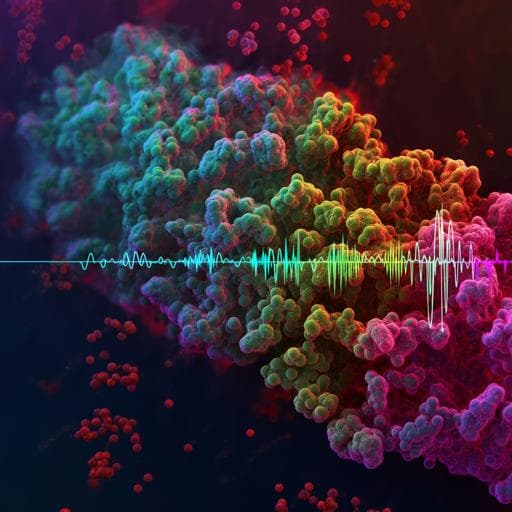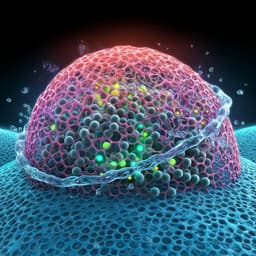
Environmental Studies and Forestry
Machine learning assisted dual-functional nanophotonic sensor for organic pollutant detection and degradation in water
J. Zhou, Z. Wu, et al.
This groundbreaking study by Junhu Zhou, Ziqian Wu, Congran Jin, and John X. J. Zhang unveils a dual-functional thin film that excels in water purification and organic pollutant sensing. With a remarkable 98%+ degradation efficiency and an impressive enhancement factor of 1056 for SERS signals, it pushes the boundaries of environmental science using machine learning for real-time detection.
~3 min • Beginner • English
Introduction
Access to clean water remains a global challenge, with 2 billion people lacking safely managed services. Organic pollutants (e.g., pharmaceuticals, pesticides, personal care products, detergents) are persistent and toxic, complicating purification and monitoring. Traditional methods (chemical precipitation, filtration, adsorption, ion exchange, chlorination, distillation) face limitations such as long processing times, incomplete removal, chemical resistance, and potential re-contamination. ZnO is an eco-friendly photocatalyst and piezocatalyst effective under UV (including sunlight), but improvements are needed in degradation efficacy, prevention of secondary contamination, and reusability. Anchoring ZnO nanostructures on robust silica nanofibers (SNFs) can increase contact area, prevent nanopollution, and improve reuse. Monitoring organic pollutants requires sensitive and selective detection; SERS is label-free and ultrasensitive but interpreting complex spectra is challenging. Machine learning (ML), including deep learning (DL), has been applied to Raman/SERS data; however, detecting out-of-distribution (OOD) samples and handling mixtures remain difficult. This study aims to develop an SNF-based film integrating ZnO nanorods and Ag nanoparticles (AgNP-ZnONR-SNF) to achieve both efficient degradation and rapid, label-free SERS detection of pollutants. A DL pipeline with a Laplacian operation enables qualitative, quantitative, and OOD detection of mixed contaminants without extensive preprocessing.
Literature Review
The paper reviews: (1) conventional water purification methods and their shortcomings; (2) ZnO’s photo- and piezocatalytic activities and various ZnO nanostructures (nanospheres, nanorods, nanofibers) for pollutant degradation, noting benefits of immobilizing ZnO on silica substrates to enhance stability, surface area, and reusability; (3) analytical techniques for contaminant detection, including photoluminescence spectroscopy, high-resolution mass spectrometry, liquid chromatography, and SERS; (4) challenges in SERS data interpretation due to mixed features, noise, and sample variability; and (5) ML/DL methods applied to Raman spectra (PLS, SVM, CNNs, deep learning) for classification and quantification, emphasizing persistent challenges with OOD detection and mixtures. This context motivates a unified material-platform and ML framework to both purify water and accurately sense complex pollutant mixtures.
Methodology
Materials and fabrication: Electrospun silica nanofiber (SNF) films were prepared by mixing TEOS, ethanol, water, and formic acid into a PVP matrix, stirring 1 h, and electrospinning to yield ~12 cm diameter films. ZnO nanorods (ZnONR) were grown via a seed-and-growth process: SNFs were immersed in 5 mM zinc acetate, vacuumed to remove bubbles, and baked at 180°C for 20 min to form seeds (repeated 3×). Hydrothermal growth used 35 mM zinc nitrate hexahydrate and 25 mM HMTA in DI water at 90°C for 3 h (two cycles). Films were rinsed and dried at 50°C. Ag nanoparticles were decorated by immersing ZnONR-SNF in 5 mM AgNO3 and irradiating with 365 nm UV (30 W) for 30 min, then rinsed and dried.
Characterization: SEM (FEI Helios 5CX, 5 kV) and EDS (Oxford Omni Max, 30 kV) provided morphology and elemental mapping. Average feature sizes: SNF diameter ~868 nm, AgNP ~40 nm, ZnONR length ~3 µm. Optical absorption (UV–Vis) and optical microscopy characterized film properties.
Photocatalytic and piezocatalytic degradation tests: Organic dyes (MB, TB, MO) at 10 µM initial concentration were subjected to UV irradiation and/or mechanical shaking. Control experiments (UV/shaking without catalyst) showed negligible degradation. For reusability, the same ZnONR-SNF samples were used over six cycles with drying at 50°C between cycles. Concentrations were monitored by UV–Vis absorbance at characteristic wavelengths (MB 664 nm, TB 590 nm, MO 463 nm) using aliquots sampled every 2 h; degradation efficiency was computed as (C0 − C)/C0 × 100%.
SERS measurements: AgNP-ZnONR-SNF chips (0.5×0.5 cm) were used in a liquid setup with a 10× objective and a 532 nm laser. 10 µL of analyte (e.g., Ciprofloxacin, MB) was drop-cast; spectra were collected point-by-point, including mapping (e.g., 15×15 grid over 400×400 µm²). COMSOL simulations evaluated plasmonic field enhancement versus AgNP size and spacing to guide 532 nm excitation selection and hot-spot formation.
Machine learning: Raman spectra comprised 238-point shift axes. A Laplacian operation was applied directly to spectra to accentuate peak information. A fully connected neural network (four layers of sizes 128, 64, 32, 16 with sigmoid/ReLU activations) produced two modes: (1) classification for qualitative identification (component type and above/below 5 µg mL⁻¹ threshold) and (2) regression for quantitative concentration ratios of multiple analytes. For OOD detection, KNN was combined with the NN classifier: NN outputs (8-class probabilities for mixtures of MB, TB, Cip) were clustered with KNN to detect unseen classes using a distance-to-cluster threshold. Implementation used PyTorch, scikit-learn, NumPy, SciPy on an Intel i9-9980XE CPU and NVIDIA RTX 2080Ti (8 GB). Data splits used repeated random splits and 10-fold cross-validation (e.g., 1095 total samples: 995 training, 100 test), with errors and accuracies averaged over 10 runs.
Key Findings
- Fabrication and structure: AgNPs uniformly decorate ZnONR grown on SNFs, forming 3D fibrous films with distributed hot-spots confirmed by SEM/EDS; average sizes: SNF ~868 nm, AgNP ~40 nm, ZnONR ~3 µm.
- Photocatalysis: ZnONR-SNF achieved >98% degradation efficiency for MB, TB, and MO after 8 h under UV; sunlight-driven photocatalysis was even more effective than UV lamp in supplementary tests. Films maintained performance over six reuse cycles.
- Piezocatalysis and hybrid: Under mechanical vibration alone (13.5 W shaker), piezocatalytic degradation reached up to 34.1% after 8 h (e.g., MB ~15.9%, TB ~34.1%). Hybrid UV + shaking improved rates dramatically, achieving after 2 h: MB 96.36%, TB 46.1%, MO 34.8%.
- SERS performance: AgNP-ZnONR-SNF provided strong enhancement enabling an experimental detection limit of 1 pg mL⁻¹. Compared to glass, the MB 1437 cm⁻¹ peak intensity was ~1506× higher on AgNP-ZnONR-SNF (and ~3.3× higher on ZnONR-SNF). Mapping (15×15 points over 400×400 µm²) showed uniform signal distribution, indicating good substrate uniformity. Calibration curves for Cip (1382 cm⁻¹) and MB (1437 cm⁻¹) versus concentration exhibited high linearity (e.g., R² ≈ 0.992 and 0.946).
- ML-assisted detection: NN classifier achieved 92.3% accuracy for qualitative detection and 90.8% for quantitative classification. NN regressor achieved an average absolute error of 0.327 (0–10 range) with 92% quantitative detection accuracy and could infer analyte presence from predicted concentration ratios. For OOD detection, NN classifier + KNN achieved 80% sensitivity and 89.3% specificity (vs. KNN alone: 22% sensitivity, 46.7% specificity).
Discussion
The integrated AgNP-ZnONR-SNF platform addresses two central challenges in water safety: efficient removal of organic pollutants and sensitive detection/identification of contaminants and mixtures. The 3D SNF scaffold with ZnONR maximizes surface area and facilitates both photocatalytic ROS generation and piezoelectric charge separation under mechanical stimulus, enabling high degradation efficiencies and reusability. AgNP decoration creates plasmonic hot-spots for SERS, delivering pg mL⁻¹ detection limits and spatially uniform signals suitable for quantitative sensing. The tailored ML pipeline—Laplacian preprocessing, dense NN for classification/regression, and KNN for OOD detection—resolves overlapping spectral features in mixtures and flags unseen classes with high specificity, overcoming key limitations of conventional SERS analyses and baseline clustering. Together, these results demonstrate that combining nanoengineered catalytic-sensing substrates with DL can provide rapid, label-free pollutant monitoring while concurrently degrading contaminants, advancing practical environmental monitoring and remediation.
Conclusion
This work demonstrates a dual-functional nanophotonic thin film (AgNP-ZnONR-SNF) that simultaneously enables high-efficiency photocatalytic/piezocatalytic degradation and ultrasensitive SERS detection of organic pollutants. The substrate achieves >98% UV-driven degradation with demonstrated reusability, strong and uniform SERS enhancement with 1 pg mL⁻¹ LOD, and robust DL-enabled analysis for mixtures and OOD detection (up to 92.3% classification accuracy; 89.3% specificity for unseen classes). The approach offers a cost-effective, portable, and scalable route for water purification and on-site sensing. Future work could expand analyte libraries, optimize AgNP morphology and spacing to further standardize hot-spot distributions, improve OOD sensitivity, integrate real-time flow systems, and validate performance in complex environmental matrices.
Limitations
- The OOD detection component, while specific (89.3%), achieved 80% sensitivity; broader unseen classes and larger datasets may be needed to generalize further.
- Piezocatalytic degradation alone is modest compared to photocatalysis; hybrid operation improves performance but adds complexity.
- Reported performance focuses on select dyes and one antibiotic in controlled solutions; testing in real water matrices with interferents remains to be demonstrated.
- SERS enhancement depends on AgNP size/gap and substrate uniformity; while mapping shows good uniformity locally, wafer-scale reproducibility and long-term stability are not fully characterized here.
- The approach relies on UV excitation for photocatalysis and a 532 nm laser for SERS; field deployment may require ruggedized, low-power sources and integration.
- ML models were trained and validated on limited sets; despite cross-validation, larger and more diverse datasets would strengthen generalizability and OOD detection boundaries.
Related Publications
Explore these studies to deepen your understanding of the subject.







